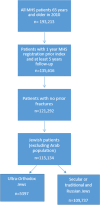Risk of major osteoporotic fractures among ultra-orthodox Jews
- PMID: 36369595
- PMCID: PMC9812995
- DOI: 10.1007/s00198-022-06522-8
Risk of major osteoporotic fractures among ultra-orthodox Jews
Erratum in
-
Correction: Risk of major osteoporotic fractures among ultra-orthodox Jews.Osteoporos Int. 2024 Sep;35(9):1679. doi: 10.1007/s00198-024-07174-6. Osteoporos Int. 2024. PMID: 38953948 Free PMC article. No abstract available.
Abstract
The Ultra-Orthodox Jewish population has behaviors that can influence the risk for osteoporotic fractures. We investigated whether this population is more prone to osteoporotic fractures than non-Orthodox Jewish. We did not find a significant difference in osteoporotic fracture rates between the two populations despite major differences in exposure to potential risk factors.
Introduction: The Ultra-Orthodox Jewish population is a conservative population with unique cultural behaviors such as modest clothing and specific dietary restrictions, which can influence bone density and risk for osteoporotic fractures. The aim of this study is to investigate whether the Ultra-Orthodox Jewish population is more prone to osteoporotic fractures than the non-Orthodox Jewish population.
Methods: This retrospective cohort study utilized computerized records from Maccabi Health Service. Study population included patients 65 years and older without a history of osteoporotic fracture, who reside in regions of Ultra-Orthodox and non-Orthodox Jews. The primary outcome was the adjusted risk to osteoporotic fracture during 9 years of follow-up. Cox regression included patient characteristics and risk factors for osteoporosis.
Results: A total of 115,134 patients were included in this study: 5397 patients residing in Ultra-Orthodox regions (51.0% female) and 109,737 patients residing in non-Orthodox regions (52.6% female). A total of 16,352 (14.2%) patients had an osteoporotic fracture during the study period. There was no significant difference in fracture rate between Ultra-Orthodox and non-Orthodox (14.3% vs. 14.2%, p = 0.827). Among Ultra-Orthodox and non-Orthodox females and males, there were no significant differences in fracture rates (19.1% vs. 19.1% p = 0.982 and 9.3% vs. 8.8% p = 0.311, respectively). The adjusted hazard risk for the Ultra-Orthodox Jews was 1.026, 95% CI: 0.95-1.11, p = 0.512.
Conclusion: We did not find a significant difference in the rate of osteoporotic fractures between Ultra-Orthodox and non-Orthodox populations despite major differences in exposure to potential risk factors. Results suggest that the perception of risk factors relevant for the religious communities should be re-evaluated.
Keywords: Cohort study; Community health; Cultural difference; Osteoporosis; Osteoporotic fracture; Sun exposure.
© 2022. The Author(s).
Conflict of interest statement
None.
Figures
Similar articles
-
Reduced spinal bone mineral density in adolescents of an Ultra-Orthodox Jewish community in Brooklyn.Pediatrics. 2001 May;107(5):E79. doi: 10.1542/peds.107.5.e79. Pediatrics. 2001. PMID: 11331729
-
Pediatric Burns Unique Characteristics Among Ultra-Orthodox Jewish Minority-Retrospective Study.J Burn Care Res. 2022 May 17;43(3):596-601. doi: 10.1093/jbcr/irab188. J Burn Care Res. 2022. PMID: 34651639
-
Effect of different dress style on vitamin D level in healthy young Orthodox and ultra-Orthodox students in Israel.Osteoporos Int. 2011 Nov;22(11):2895-8. doi: 10.1007/s00198-010-1492-y. Epub 2010 Nov 26. Osteoporos Int. 2011. PMID: 21110005
-
Hidden Figures: Are Ultra-Orthodox Jewish Women Really so Different When it Comes to Health Care?J Relig Health. 2020 Jun;59(3):1398-1420. doi: 10.1007/s10943-019-00862-2. J Relig Health. 2020. PMID: 31218549 Review.
-
Sexual Abuse in the Orthodox Jewish Community: A Literature Review.Trauma Violence Abuse. 2021 Dec;22(5):1086-1103. doi: 10.1177/1524838020906548. Epub 2020 Feb 13. Trauma Violence Abuse. 2021. PMID: 32054401
References
-
- Cahaner L, Malach G (2019) The Yearbook of the Ultra-Orthodox Society in Israel 2019
MeSH terms
LinkOut - more resources
Full Text Sources
Medical



